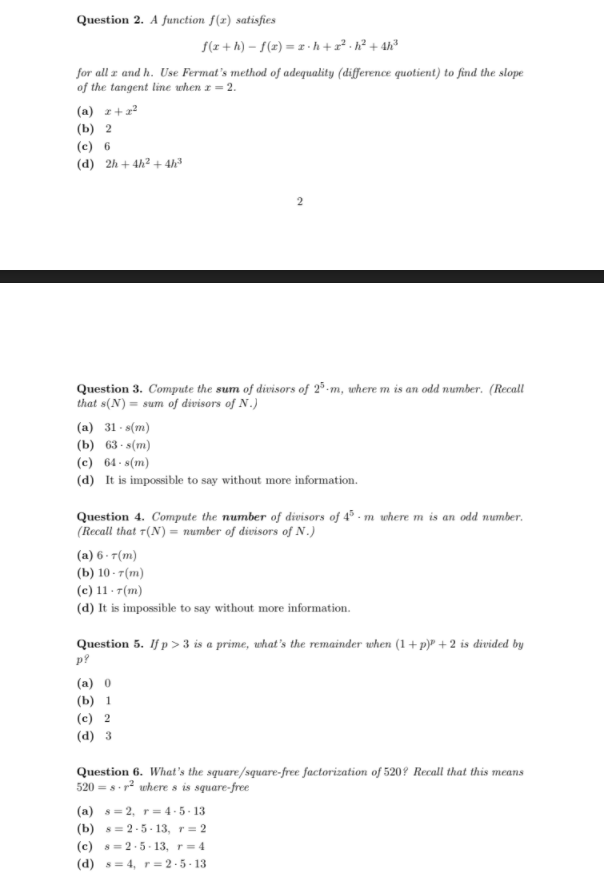Question 2. A function f(x) satisfies f(x+h)-f(x)=x+h+z² · h² + 4h³ for all z and h. Use Fermat's method of adequality (difference quotient) to find of the tangent line when z = 2. (a) z+z²
Question 2. A function f(x) satisfies f(x+h)-f(x)=x+h+z² · h² + 4h³ for all z and h. Use Fermat's method of adequality (difference quotient) to find of the tangent line when z = 2. (a) z+z²
Algebra & Trigonometry with Analytic Geometry
13th Edition
ISBN:9781133382119
Author:Swokowski
Publisher:Swokowski
Chapter7: Analytic Trigonometry
Section7.6: The Inverse Trigonometric Functions
Problem 93E
Related questions
Question
Only need the Multiple choice answers, not the steps.

Transcribed Image Text:Question 2. A function f(z) satisfies
S(z + h) – f(z) = 2 ·h+x² · h² + 4h³
for all z and h. Use Fermat's method of adequality (difference quotient) to find the slope
of the tangent line when x = 2.
(a) z+z?
(b) 2
(c) 6
(d) 2h + 4h² + 4h³
Question 3. Compute the sum of divisors of 2³-m, where m is an odd number. (Recall
that s(N) = sum of divisors of N.)
(a) 31 - s(m)
(b) 63 - s(m)
(c) 64 - s(m)
(d) It is impossible to say without more information.
Question 4. Compute the number of divisors of 4³ - m where m is an odd number.
(Recall that 1(N) = number of divisors of N.)
(a) 6 - 7(m)
(b) 10-т(m)
(c) 11 · 7(m)
(d) It is impossible to say without more information.
Question 5. If p> 3 is a prime, what's the remainder when (1+ p)P + 2 is divided by
p?
(a) 0
(b) 1
(c) 2
(d) 3
Question 6. What's the square/square-free factorization of 520? Recall that this means
520 = s r2 where s is square-free
(a) s=2, r= 4 -5 - 13
(b) s= 2-5- 13, r= 2
(c) s=2.5 - 13, r= 4
(d) s= 4, r= 2-5- 13
Expert Solution
This question has been solved!
Explore an expertly crafted, step-by-step solution for a thorough understanding of key concepts.
Step by step
Solved in 2 steps

Knowledge Booster
Learn more about
Need a deep-dive on the concept behind this application? Look no further. Learn more about this topic, advanced-math and related others by exploring similar questions and additional content below.Recommended textbooks for you

Algebra & Trigonometry with Analytic Geometry
Algebra
ISBN:
9781133382119
Author:
Swokowski
Publisher:
Cengage

Algebra & Trigonometry with Analytic Geometry
Algebra
ISBN:
9781133382119
Author:
Swokowski
Publisher:
Cengage